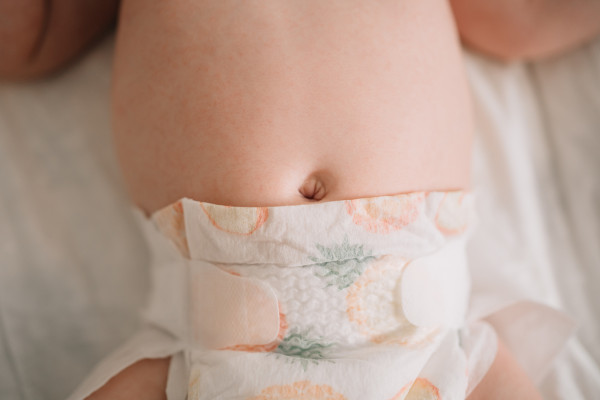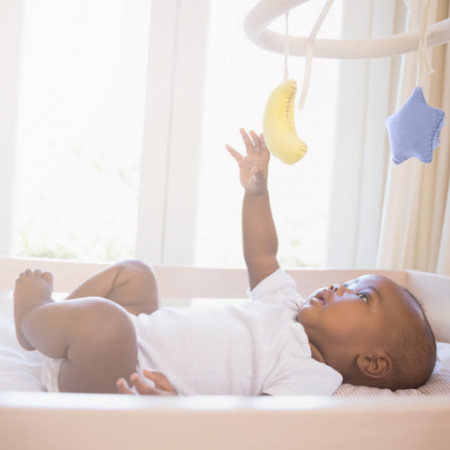
Everyday care
Baby’s wellbeing
Every day, you will be taking a thousand and one small decisions for the wellbeing, happiness, health, and safety of your child.
Feeding your baby well is important, but there’s more! You will also be bathing her, watching over her sleep, interpreting her cries, understanding her, looking after her, and supporting her growth and her learning, day after day—such a fabulous adventure!
Guarding your baby’s sleep
In the early days, your baby will sleep 16 to 18 hours a day. She will require less sleep as she grows. Whether she is sleeping through the night or not, the quality of her sleep is the cornerstone of her balance and of a healthy development.
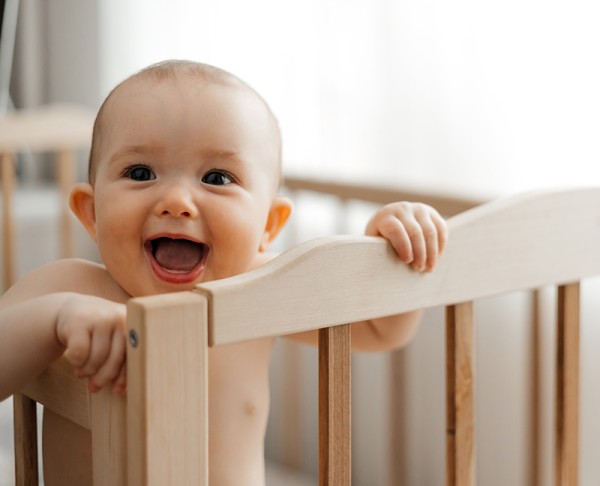
Beds
In the first few months, you may want to keep your baby near you, though it might mean disrupting the few hours of sleep that you will manage to snatch. Alternatively, put her bed in the next room, so you hear her when she wakes up, for accessible breastfeeding and nappy changing.
Feel into how close you need to be to your child, especially right after birth. Later, as she starts sleeping through the night, get her used to sleeping in her own room. As time goes on, she will react more to surrounding sounds and movements: her sleep will be easier to disturb if she is sleeping beside you.
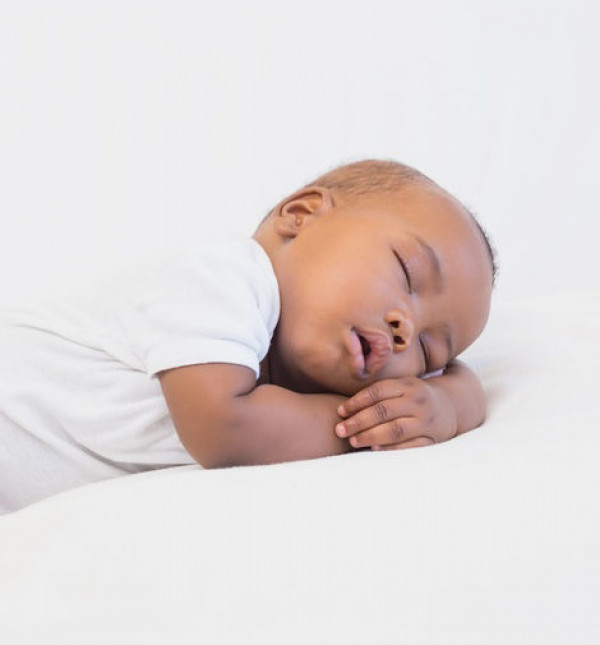
Before 1 year
Aside from when she is breastfeeding, your baby sleeps deeply most of the time, interrupted by periods of being fully awake. She wakes every 3 to 4 hours and eats 6 to 8 times a day. Needless to say, her sleep rhythms are very different from yours.
Starting at 2 months of age, she will begin to tell the difference between night and day. Her environment will have an influence on her phases of wakefulness and sleeping.
From the age of 3 months, she will suddenly fall into peaceful slumber. Sleep will deepen until the short, intense paradoxical sleep phase, during which she will dream.
Though it may seem that your baby is not sleeping much, she will recharge her batteries through brief naps lasting 30 minutes to an hour. Additionally, she will start sleeping through the night without being hungry.
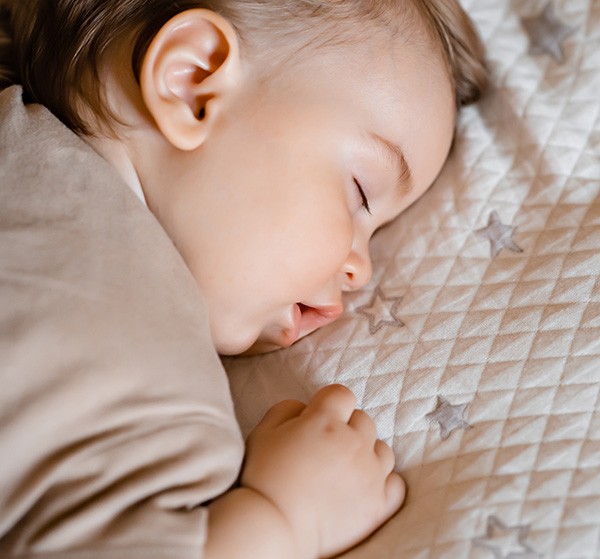
After 1 year
Your baby’s rhythms will change, with less sleep during the day. Her naps will get shorter, some may disappear altogether.
Her temperament will grow stronger, and she may complain when you put her to bed. Let her know that it will soon be time for bed so she has time to finish what she is doing and to prepare for sleep.
Your child thrives on habits and on a bedtime ritual: a lullaby, bedtime stories, hugs, and anything you can share, being careful not to get her overly excited before bed.
A soft toy, a nightlight, and keeping the door ajar are some of the little habits you can establish to reassure her that she isn’t alone at night.
As your child grows, you can give her some quiet time to unwind in bed (without a screen) before falling asleep.
Safe and secure
Your baby’s bed will be a safe haven by taking basic precautions:
- Lay your child down on her back, not on her tummy. This position is now acknowledged as reducing the risk of sudden death syndrome in infants.
- Choose a firm mattress that is adapted to the size of the bed, making sure there are no gaps around the edges.
- No pillows, sheets, or blankets: the best is to have her sleep in a sleeping bag or a playsuit. No duvets before 36 months of age. Also avoid piling soft toys on her bed, especially large ones, or tying her dummy to a string. All this will reduce risks of suffocation.
- Ideally, set the temperature to 19° C in her bedroom.
- No pets in baby’s bedroom, for both hygiene and safety.
- When your baby is awake, you may turn her on her tummy to strengthen her back muscles and to show her the world from another angle.
Sleep disorders
Night waking is disruptive for your child, but also for her parents and for the whole family. Be gentle and firm about teaching her to fall asleep by herself.
- Anxiety: some children get scared at bedtime. They may be afraid of the dark, of being alone in their bedroom, of knowing that life goes on without them in the next room, or of monsters hiding under the bed or behind the curtains. A change of habits, tension in the family, moving house, a TV programme or her own wild imagination can also be fear inducing.
If your child is anxious and calls for you at night, try to find out what she is afraid of, reassure her using a gentle voice, chase the monsters away, and give her a snuggle. A nightlight will often be enough to overcome her fear of the dark.
If her fear turns into a phobia, speak to her paediatrician rather than letting her climb into your bed. - Excitement: as your child grows, she may find it harder to fall asleep and even dislike waking up several times in the night. She will call out to you each time, asking you to help her go back to sleep again. At first, you can reassure her and explain that she needs to sleep to be full of energy for the next day.To help her settle down and fall asleep again, establish a simple ritual that she will be able to do without you: holding her soft toy, turning the other way, looking at her nightlight… Going forward, you will need to resist the temptation to comfort her and wait for her to go back to sleep by herself.
- Nightmares: every parent has experienced jumping out of bed and finding their child terrorised and crying, in a muck sweat. Your calmness will be the best reassurance: explain that it was only a nightmare and help her go back to sleep.
If her night terrors continue, don’t hesitate to talk to her doctor.
Our answers to your questions
-
Your baby must learn to fall asleep again by herself in between sleep cycles. If she sleeps through the night, she will go back to sleep—otherwise, she will wake you up. Lying alone on her back, in the dark, she is crying for reassurance.
Help her find her own rhythm, with minimal intervention: lay her down in her bed, gently stroke her head to reassure her, and wait for her to go back to sleep by herself, even if she cries a little.
Practising at naptime will make this easier to do at night.
Washing your baby

Face
- Eyes: check the corner of her eyes, where secretions sometimes build up: to remove them, use a cotton pad dipped in warm boiled water or saline solution, wiping from the inner corner of the eye towards the outside.
- Nose: it can often be congested with mucous. However, breathing freely is essential to breastfeeding: clear your baby’s nose by gently removing whatever is blocking it up with a cotton swab dipped in warm boiled water or saline solution.
- Ears: clean the outer ears with special cotton swabs for babies to prevent any damage to the eardrums. Do not try to reach the end of the ear canal, which contains small hairs that push earwax out.

Head
Be gentle, especially while the fontanelle is still open. Until your baby has hair, you may use the same soap as the one you use for her body. When her hair comes in, wash it with gently baby shampoo. She will probably not like getting soap and water in her eyes and will be quite vocal about that!
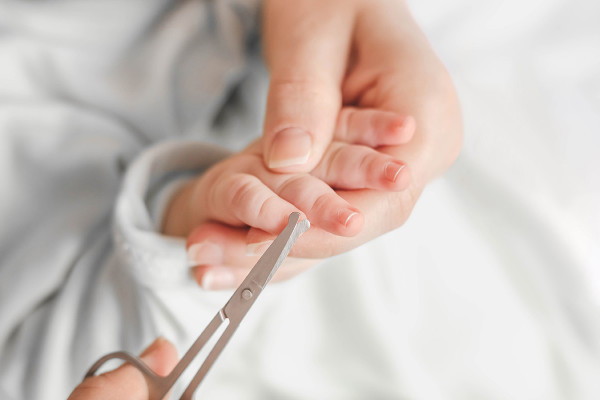
Hands
Your baby’s nails will grow very fast and are so tiny that you may hesitate to trim them. It may be easier to wait until she is deep asleep to cut them with small rounded baby scissors. Do not cut them too short: the nails must be slightly longer than the fingertips.
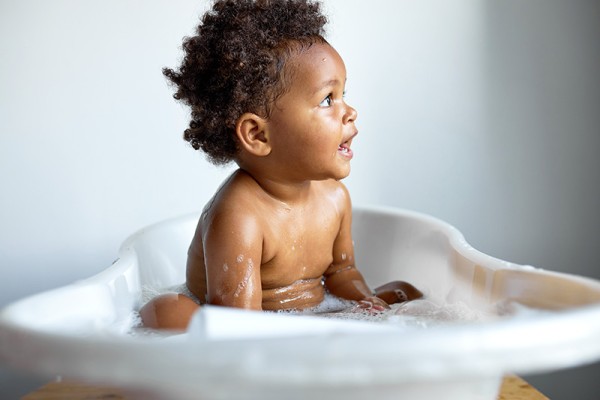
Bathing
This is a lovely time for sharing with your baby. In the early weeks, you can bathe her in a sink, but going forward, getting a special baby bath will make things easier. She will be ready for a big bathtub when she is bigger.
Generally speaking, never take your eyes off your child when she is in the tub. Hold her with your free hand as you wash her with the other.
Check the water temperature with a bath thermometer: it should be 37°C maximum.
You will find it easier if you set a few things out next to you in advance: soap and bath toys, as well as the changing mat covered with a towel and a nappy ready for when baby comes out of the bath.
Baby will splash about very happily in the bath and wriggle more and more on the changing table. Make sure it is stable. If they have dry skin, get a moisturising ointment – your doctor will be able to recommend one.
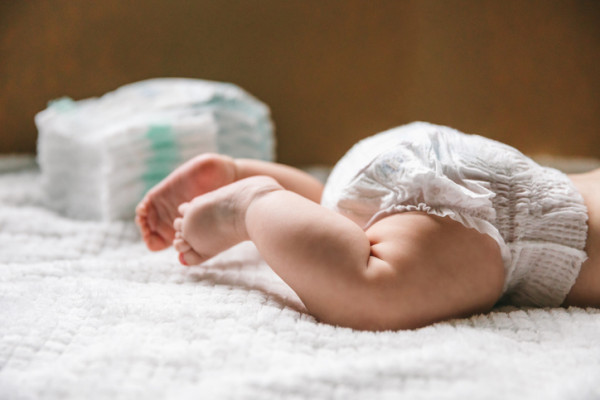
Nappies
Your baby’s skin is fine and fragile. Her little bottom may get red quite easily. You will need to change her nappy after each feed, or when you notice that she is soiling herself. Clean her skin with a cotton pad or loo roll, soap, and water. If you use a flannel to wash her bottom, use a fresh one every day, and wash soiled ones at 90°C to remove all faecal bacteria.
Dry your baby’s bottom thoroughly, as faeces, urine, and moisture can all irritate the skin.
Your doctor will prescribe an ointment or cream for nappy rash, which you should keep on hand as a last step.

My baby is crying!
You will need to learn to overcome the pang of hearing your baby cry.
Many things can make a baby cry: frustration, such as tiredness, hunger, physical discomfort, or anxiety. Try to find what is causing it as soon as possible.
You will soon be able to understand variations in your baby’s first method of communication.
It is normal for your baby to cry a lot in the first 3 months of life. She has no other way of calling for you, and is adapting to her new environment, having spent nine months in the peacefulness of your tummy.
Mentally run through the reasons why she may be crying: is she in an uncomfortable position? Is she hungry? Has she been woken by a sound? Has she soiled her nappy?
Once you have eliminated major causes of discomfort, remember that her crying might also be a way of letting off steam, often the cause of evening crying. Your baby is evacuating stress. Let her express herself and reassure her as you rock her in your arms. To help her calm down, you can sing her a song that you used to hum when she was still in your tummy, speak softly, and try to distract her. You could also play her music box, have her look at her mobile toy, shake a rattle, etc.
Find the right balance between letting her cry it out and picking her up.
If your baby’s cries are louder than usual with no apparent reason: if she is grimacing in pain, take her temperature, check for signs of digestive or other disorders, and call your doctor for a diagnosis and a course of action.
